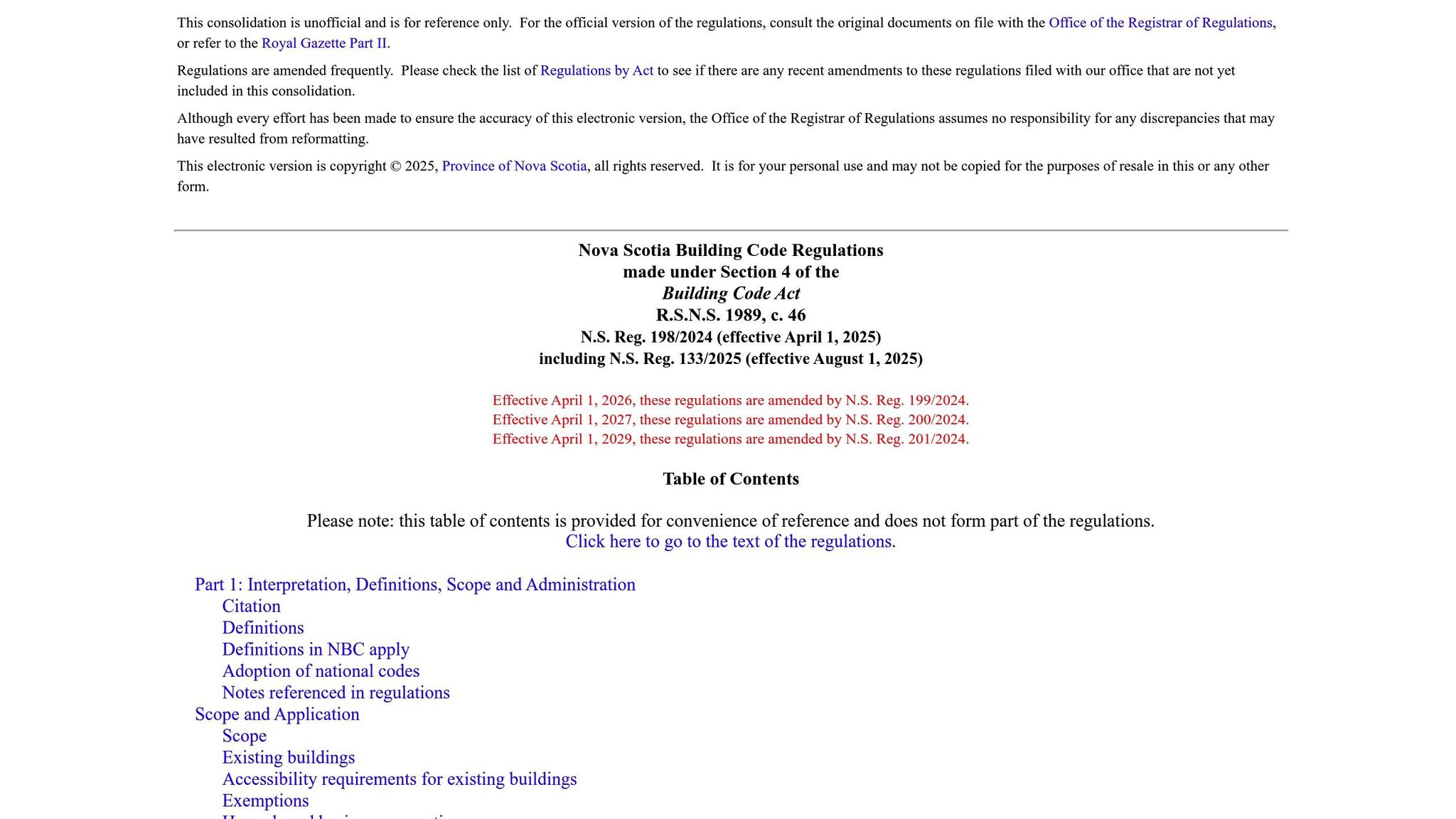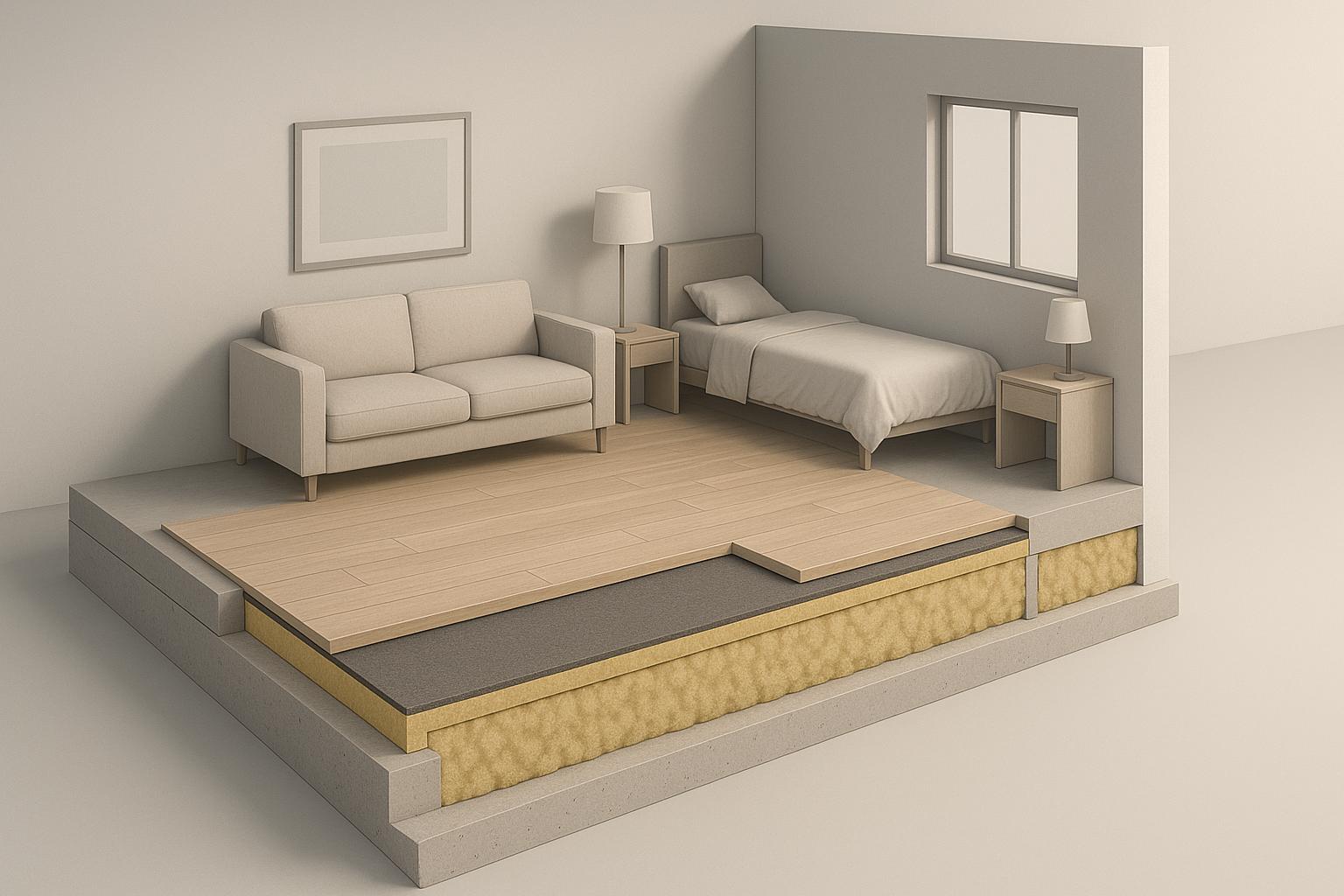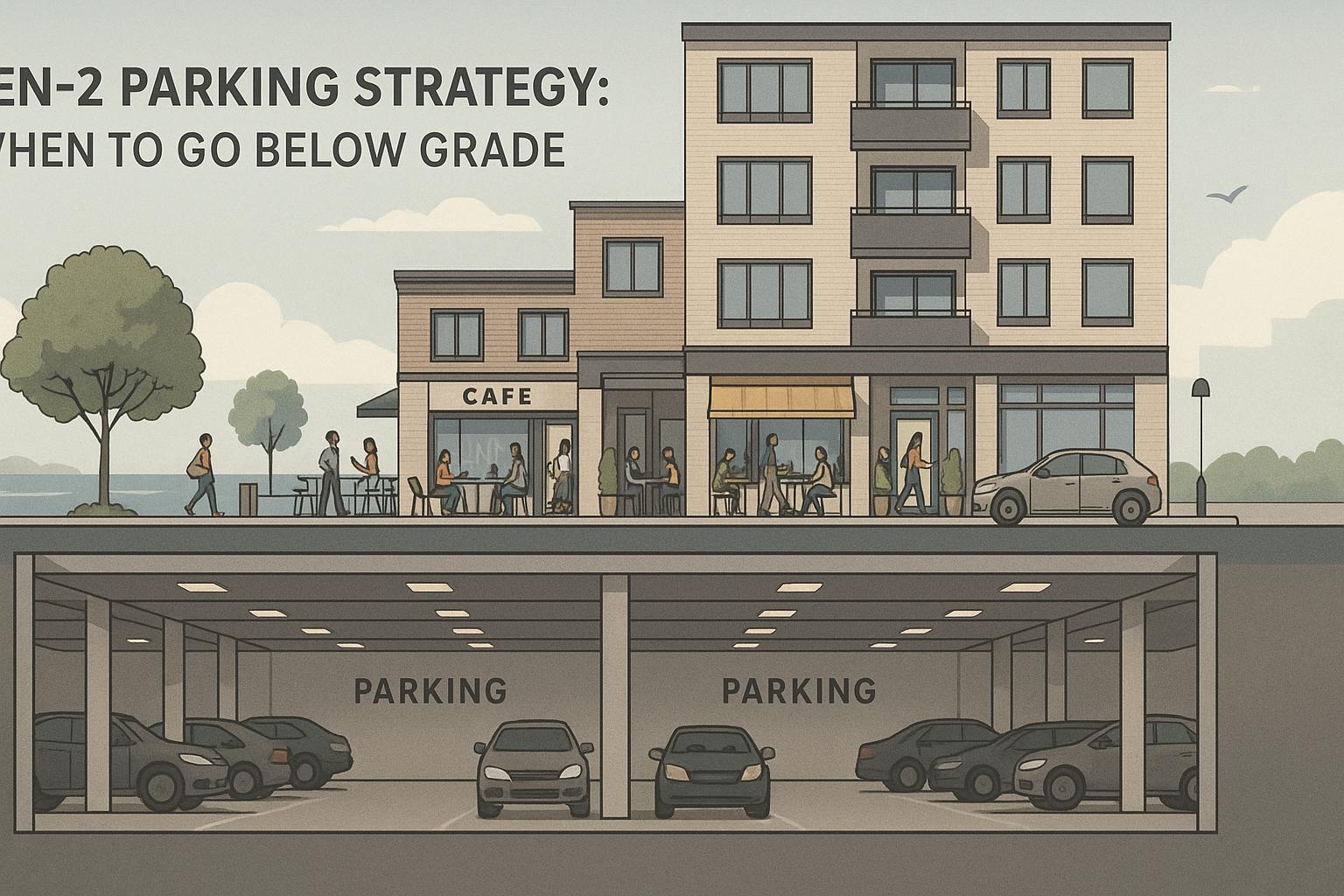Building width and depth can make or break a multi-unit rental project in Nova Scotia's COR corridors. While zoning allows for taller, denser buildings, poor design choices can lead to cramped layouts, tenant dissatisfaction, and costly delays. Proper planning ensures compliance with municipal bylaws and provincial codes while maximizing land use and profitability.
Key Takeaways:
- Zoning Rules: Setbacks, lot coverage, and height transitions dictate building dimensions.
- Challenges: Irregular lots, slopes, and frontage limits require careful adjustments.
- Future-Proofing: Flexible designs accommodate market changes, like reduced parking demand or phased expansions.
- Construction Methods: Integrated design-build reduces delays, budget overruns, and miscommunication compared to fragmented approaches.
Why This Matters: Nova Scotia's housing shortage and rising demand for rental units make COR corridor projects a lucrative opportunity. Focusing on efficient building dimensions and streamlined construction processes ensures long-term success.
We Designed 6 Apartments on a 50x100 Plot and Here's What Happened
Nova Scotia Zoning Rules and Site Limits
In Nova Scotia, multi-unit construction projects operate under a two-layer system of regulations: municipal bylaws and provincial codes. These rules work together to determine site dimensions, shaping how building width and depth are adjusted to fit each property.
Municipal Zoning Rules
Every municipality in Nova Scotia enforces its own Land Use Bylaws, which regulate key aspects of property development like building size, placement, and height [3]. These bylaws vary depending on the zoning of the area.
For projects in COR corridors, municipal bylaws play a significant role in defining your building's potential width and depth. For instance, setback requirements specify how far a building must be positioned from property lines, while lot coverage ratios limit how much of the land can be built upon. Before a building permit is issued, compliance with all applicable bylaws and agreements must be verified [1][2].
Common Site Problems
Most construction sites are far from perfect. Irregular shapes, narrow frontages, sloping land, or utility easements often require early design adjustments. These challenges make it essential to creatively maximize usable space while staying within setback and lot coverage rules.
Nova Scotia Building Code Requirements

The Nova Scotia Building Code Regulations are based on national standards but include adjustments specific to the province [2]. While the code establishes minimum requirements, factors such as fire separation and barrier-free design can significantly influence interior layouts.
Minor deviations - up to 2% - are permitted, provided safety and accessibility aren't compromised [1][2]. However, any variation requires formal approval as well as pre- and post-construction land surveys [1][2].
How Width and Depth Changes Help Multi-Unit Rental Properties
Tweaking the width and depth of buildings can set multi-unit rental properties up for long-term success. These adjustments make properties more adaptable to shifting market trends and regulatory updates. By incorporating flexibility into the design, property owners can maintain profitability and stay competitive as tenant needs and market conditions evolve [4]. This kind of forward-thinking approach also opens the door to various future strategies, such as reimagining parking spaces, planning phased expansions, or integrating features that cater to a broader range of tenants.
Future Options for Property Owners
Preparing for the future starts with adaptable infrastructure. Flexible plumbing and electrical systems, for instance, make upgrades easier and minimize disruptions [4]. Similarly, designing buildings with versatile dimensions allows spaces to be reconfigured as market demands shift.
A great example of this is the declining need for on-site parking. With fewer tenants relying on personal vehicles, parking structures can be transformed into residential units or office spaces [5]. Thoughtfully planned building dimensions make these transitions smoother and more cost-effective [5].
Phased construction is another benefit of flexible design. Property owners can begin with a smaller number of units and expand later as financing becomes available. This requires careful planning to ensure that any future additions blend seamlessly with the original structure, avoiding the need for costly retrofitting.
Universal design principles also play a key role in future-proofing properties. Features like wider hallways, deeper bathrooms, and adaptable room layouts make units accessible to a broader range of tenants. As demographics change over time, these design elements can help meet the needs of a more diverse tenant base [4].
sbb-itb-16b8a48
How Integrated Construction Handles Design Changes
Adjusting the dimensions of multi-unit rental properties - whether it’s width, depth, or both - requires a high level of coordination. The method you choose to manage these changes, either traditional construction or integrated design-build, can make or break your project's efficiency and budget.
Problems with Traditional Construction
In traditional construction, your project is divided among six or more separate entities: architects, engineers, planners, contractors, and various specialists. When design changes are needed, this fragmented setup often leads to a host of issues.
Coordination breakdowns cause delays. Imagine your architect designs a building width that looks great on paper, but then the structural engineer discovers the soil conditions demand deeper foundations. Meanwhile, the contractor is pricing the original design, and the plumber is planning based on the initial layout. Each group works in isolation, creating a domino effect of miscommunication and rework.
Budget overruns hit hard. Traditional construction is notorious for exceeding budgets - by 30-60% on average - largely due to design changes. Each professional involved adds their markup to modifications, and because updates aren’t coordinated, you end up paying multiple times for the same adjustment as it filters through different contracts.
Timelines stretch far beyond expectations. What starts as an 8-month project can easily drag out to 18 months or more. Every design change halts progress as contractors reprice their portions. Even if the electrician is ready next week, the framer might not be available for two months. These scheduling conflicts multiply when changes impact multiple trades.
Accountability disappears in a blame game. If revised dimensions fail to meet Nova Scotia Building Code standards, the architect might point fingers at the engineer, who then blames the contractor. Meanwhile, you’re stuck mediating disputes instead of moving forward. This lack of accountability undermines both reliability and progress.
Benefits of Integrated Design-Build
Integrated design-build offers a completely different approach, addressing the inefficiencies and delays of traditional methods. This model unites planners, architects, engineers, and construction teams under one company, allowing for seamless handling of design changes like width and depth adjustments.
Thorough site analysis and upfront compliance. With everyone working together from the start, the team evaluates your property holistically - considering land conditions, surrounding streetscapes, and zoning rules. They also address Nova Scotia Building Code restrictions on height, lot size, and spacing between structures right from the get-go [6][7].
Collaborative problem-solving replaces finger-pointing. When site-specific challenges require changes, the integrated team works as a unit to find solutions. For example, the structural engineer and architect can sit down together to ensure adjustments are both structurally sound and visually appealing.
3D modelling simplifies decision-making. Integrated teams use advanced 3D models to test different width and depth configurations virtually. This allows you to see how changes will impact lighting, views, and privacy before construction even begins [6].
One-point accountability streamlines the process. With a single company overseeing the entire project, there’s no room for the blame game. If a design change causes an issue, the integrated team takes full responsibility for resolving it.
Results: Traditional vs Integrated Construction
The advantages of integrated construction become especially clear when comparing outcomes:
| Factor | Traditional Construction | Integrated Construction |
|---|---|---|
| Budget | 30-60% overruns common | Fixed pricing, $0 overruns |
| Schedule | 12-18 months typical | 6 months |
| Design Change Cost | Multiple markups per change | Single pricing adjustment |
| Accountability | 6+ separate contracts | One company responsibility |
| Quality Control | Fragmented inspections | Triple verification system |
| Communication | Property owner coordinates | Daily photo updates |
Real-world data underscores these differences. Traditional construction often leaves property owners managing coordination between contractors, resulting in an average of $47,000 wasted on inefficiencies. Integrated construction eliminates this waste by consolidating all professionals into a single team.
Financial guarantees protect property owners. Companies like Helio Urban Development offer penalties of up to $1,000 per day for missed deadlines, shielding owners from the $8,800 monthly loss in rental income caused by delays.
Enhanced quality control. Integrated teams conduct Professional Engineer inspections at least five times during construction, with the property owner choosing the final inspector. All work is backed by two-year warranties, ensuring peace of mind.
When design changes like width and depth adjustments arise, the integrated approach keeps your project on track. Instead of halting progress for multiple contractors to reprice and reschedule, the integrated team makes internal adjustments and sticks to the guaranteed timeline. This streamlined process highlights why integrated design-build is the smarter choice for handling complex construction projects.
When to Change Building Width and Depth
Sometimes, the shape and size of a building need to be adjusted to suit the site conditions. Knowing when and how to make these changes can help ensure the project aligns with municipal rules and avoids potential permitting headaches.
Common Reasons for Width and Depth Changes
Zoning setbacks can dictate dimensions.
Municipal bylaws often set rules for setbacks and parking, which directly influence how wide or deep a building can be on a given lot.
Frontage limitations may call for narrower designs.
For example, a duplex typically requires about 50 feet of frontage, while a fourplex might need 80 feet or more [8].
Rural lots often need narrower, deeper buildings.
In Nova Scotia, provincial regulations usually require at least 30 metres (around 100 feet) of frontage for new lots [8]. On properties with less frontage, buildings must be designed to be narrower and extend deeper into the lot.
Topography can impact building design.
Challenging features like steep slopes, rocky terrain, or irregular lot shapes can increase construction costs and limit the available building area [8].
Environmental factors may restrict buildable space.
Features such as wetlands or prior industrial use can reduce the usable area of a lot, often forcing buildings into specific configurations [8].
These factors highlight why it’s essential to plan carefully when designing a building to fit a specific site.
How to Make Design Decisions
Start with a thorough site analysis.
Before purchasing land for a multi-unit project, review municipal zoning bylaws to understand what’s allowed. Pay close attention to setbacks, parking rules, and other restrictions [8].
Check that the lot meets minimum requirements.
Ensure the lot satisfies the minimum area and frontage standards for your project to avoid permitting issues later [8].
Evaluate the topography and environmental challenges.
Bring a builder into the process early to assess the land for steep slopes, environmental constraints, or other potential issues [8]. Early planning can save time and money by reducing delays and unexpected costs.
Nova Scotia Project Examples
Real-world examples from Nova Scotia show how adapting building designs to site conditions can lead to better outcomes.
Corner lot redesign in Halifax.
A property owner in Halifax’s north end faced strict setback rules on a corner lot with good street frontage. By narrowing and deepening the building design, the team was able to meet setback requirements and include the necessary parking, all while maintaining functional unit layouts.
Rural frontage workaround in Colchester County.
A rural property owner in Colchester County had a lot with only 25 metres of frontage - below the provincial minimum. The design team created a narrower, deeper building that worked within the limited frontage while accommodating the planned rental units.
Slope-friendly design in Bedford.
On a sloped lot in Bedford, the original design called for a wide, shallow building that would have required significant excavation. By switching to a narrower, deeper footprint that followed the slope, the team minimized excavation costs and improved the overall layout of the units.
These examples underscore the importance of tailoring designs to the unique challenges of each site. Early adjustments can save time, reduce costs, and help projects move forward smoothly.
Key Points for Property Owners
When planning your next property investment, there are several critical factors to consider that can help you make the most of your project. By focusing on building width and depth, you can ensure your investment delivers strong returns and operates efficiently.
Responsive design in Nova Scotia's COR corridors can boost ROI by tailoring building dimensions to lot conditions. Multi-unit buildings often provide higher income-to-cost ratios compared to single-family homes, meaning better cash flow and a stronger return on investment [9].
Energy-efficient upgrades are more affordable with smart design choices. Features like heat pumps, upgraded insulation, and modern windows are essential for cutting operating costs. Heating alone can account for 10-20% of operating expenses for rental properties in Nova Scotia [9]. By designing your building to make the most of these systems, you can charge higher rents while keeping tenant utility bills reasonable.
An integrated design-build approach simplifies adjustments to width and depth. This method brings all trades together under one contract, reducing the risk of miscommunication and expensive change orders. It’s a practical way to avoid budget overruns and delays often seen in traditional construction projects.
Strategic design can turn cash flow challenges into opportunities. For example, Halifax properties often struggle with negative cash flow under standard financing. However, adjusting building dimensions can create space for basement suites or other revenue-generating units (where zoning allows), transforming potential losses into positive cash flow [9].
Nova Scotia’s housing shortage works in your favour. The province is experiencing a severe housing shortage, especially in areas with growing populations and strong economies. This supports property appreciation and rental demand. With 14,234 permanent immigrants expected in 2024, multi-unit properties designed to meet this demand offer a solid investment opportunity [9].
Early involvement from experts can save you time and money. Consulting professionals early in the process can help you determine the ideal width and depth for your building, ensuring compliance with bylaws and site conditions. This proactive step can save you thousands by avoiding costly redesigns and delays.
FAQs
How do zoning rules in Nova Scotia’s COR corridors influence the design of multi-unit rental buildings?
Zoning regulations in Nova Scotia’s COR corridors aim to support mixed-use development by permitting multi-unit buildings up to 7–8 storeys, often featuring retail spaces on the ground floor. This approach encourages efficient land use while offering flexibility in design, making it a smart choice for property owners seeking to maximize their investment potential.
Important guidelines, like streetwall requirements, play a significant role in shaping how building facades and entrances connect with the streetscape, balancing practicality with visual appeal. Meanwhile, land use bylaws and the Nova Scotia Building Code establish clear standards for safety, density, and unit layouts. These rules directly influence how many units you can build and their configurations, ensuring designs meet municipal goals while addressing tenant needs effectively.
What are the advantages of using an integrated design-build approach for multi-unit rental projects?
An integrated design-build approach simplifies construction by uniting the design and building services within a single team. This setup often results in shorter project timelines, better teamwork, and the ability to spot potential issues early on.
With clear communication and shared accountability at its core, this method helps minimize delays and keeps unexpected costs in check. For multi-unit rental developments, it means a more streamlined process, tailored solutions for the site, and a smoother path to project completion.
How can adjusting the width and depth of a building design improve the long-term flexibility of a rental property?
Tweaking the width and depth of a building's design can make a rental property much more versatile over time. By introducing smart variations, property owners can create layouts that meet shifting tenant needs - whether that's offering different unit sizes or configurations to attract a broader range of renters. This kind of planning keeps the property appealing and competitive in the market.
Making these design adjustments also ensures efficient land use. It allows owners to make the most of their rental income potential while adhering to local zoning rules. Thinking ahead and designing for flexibility means owners can adapt to changes in market demand more easily, keeping the property profitable and performing well in the long run.



